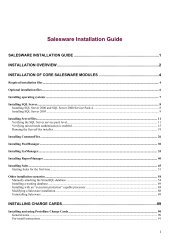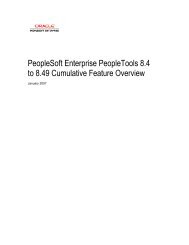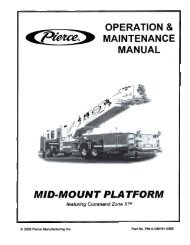COGNOS Business Intelligence Series 7
pes.pdf
pes.pdf
You also want an ePaper? Increase the reach of your titles
YUMPU automatically turns print PDFs into web optimized ePapers that Google loves.
Appendix B: Batch Administration<br />
This section describes the command-line options you can use to perform batch administration on<br />
PowerPlay servers.<br />
The ppadmtool Program<br />
Name<br />
Synopsis<br />
With the ppadmtool program, you can execute PowerPlay Enterprise Server commands directly<br />
from the Windows command prompt or UNIX command shell. The ppadmtool program saves<br />
you time. You can<br />
• enter your instruction from the command line rather than launching PowerPlay Enterprise<br />
Server Administrator<br />
• redirect stdin to use batch commands<br />
• redirect stdout to a log file<br />
In UNIX, the command-line administration tool can be accessed by using the ppadmtool.sh script.<br />
This script sets the appropriate environmental variables and starts the command line<br />
administration tool. Parameters appended to the script are passed to the administration tool for<br />
processing.<br />
After installation, the location of this script in UNIX is in the bin folder.<br />
Run this script using one of the following formats:<br />
• ./ppadmtool.sh<br />
• ./ppadmtool.sh CONNECT servername USER username<br />
• ./ppadmtool.sh CONNECT servername USER username PASSWORD password<br />
• ./ppadmtool.sh CONNECT servername:port/password (non Access Manager mode)<br />
ppadmtool - PowerPlay Enterprise - Server Administration<br />
You can issue single commands that connect and perform the desired action, for example<br />
PPADMTOOL CONNECT server[:port][/password] [option ...]<br />
or you can start a session by typing ppadmtool on the command line. You can then issue the<br />
following commands against PowerPlay servers, cubes, and reports until you type exit.<br />
ADD type name [PATH path] [DS mirror]<br />
ADD DS type name DS mirror<br />
CONNECT server[:port][/password]<br />
CONNECT server[:port] USER username PASSWORD password<br />
CD folder<br />
COPY name name<br />
CRN REPLACE {(GATEWAY | CUBENAME)} old_value new_value<br />
DISABLE name<br />
ENABLE name<br />
EXIT<br />
Enterprise Server Guide 101
















